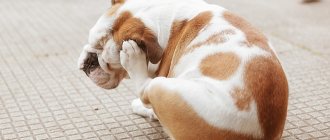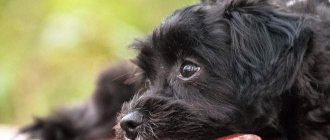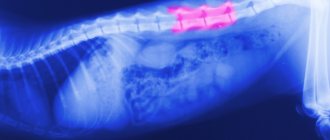Dogs, especially those living in cities, where they, like humans, are negatively affected by a large number of unfavorable factors, ranging from the environment to allergenic foods, are susceptible to a variety of diseases.
Often our faithful friend begins to itch for no apparent reason, licks or even chews on the itchy area of skin. May scratch an itchy area of skin until a sore appears and cause a staph infection (staph infection in dogs) or streptococcal infection (streptococcosis in dogs and cats).
In such a situation, dog owners strive to establish the cause of this behavior as quickly as possible, to determine and understand why the dog suddenly began to constantly itch and gnaw on certain parts of the body.
Causes of itching in dogs
Various ectoparasites.
Insects that parasitize animals include not only the well-known fleas (fleas on dogs), but also other arthropods - lice, ticks (ticks on dogs), lice eaters.
Owners who have treated their dog for fleas cannot be completely sure that they have managed to get rid of them. Since flea eggs and larvae can remain on the dog's bedding, in furniture upholstery and carpets. Therefore, you need to once again carefully examine the dog’s fur to identify eggs and adult fleas.
If the dog continues to itch, but does not have fleas, you need to examine the skin for the presence of other insects:
Ticks : dogs are most often parasitized by three types of ticks: Ixodidae - are the largest ticks, which in a hungry state reach 2-3 mm in length, and when fed with blood - up to 1-1.5 cm. Scabies (internal, ear). Subcutaneous (demodectic).
After a tick attack, dog owners usually note the following symptoms in their pets: lethargy, low activity, the dog lies down more, and begins to itch. There is a change in the color of urine (the urine becomes dark, sometimes acquires a brown, brown or red tint). The visible mucous membranes and sclera of the eyes have an icteric tint. Body temperature rises to 40°C and above. Shortness of breath appears, the dog has difficulty breathing.
An attack by ixodid ticks on a dog can cause life-threatening diseases such as piroplasmosis (pyroplasmosis (babesiosis) of dogs), Lyme disease, ehrlichiosis, and hemobartonellosis. The secretion of the salivary glands of mites leads to severe itching and scratching in the dog's head, ears and neck. Externally, the dog itches all the time and scratches its skin.
Scabies mite (itchy) - parasitizes a dog's ears, where it feeds on the secretions of the sebaceous glands and wax. To get to the lymph, it gnaws passages in the skin, as a result, the affected area of the dog begins to itch very much, the dog begins to intensively scratch these areas with its front and pelvic limbs, shake its ears, and rub its auricle against surrounding objects.
With severe infestation, the dog constantly moves and practically does not sleep. Upon examination, abrasions, scratches, wounds, pustules and areas of baldness are visible on the head and ears. Otodectosis in dogs is often accompanied by weakening of hearing, up to its complete loss. From the affected ear there may be discharge of various types, most often serous, which is later replaced by purulent discharge (ear diseases in dogs).
The subcutaneous mite is capable of parasitizing on the surface of the epidermis for a long time, feeding on horny scales. When immunity decreases, the mite penetrates deep into the skin, causing severe itching. Infection with subcutaneous mites (demodex) causes a dog to lose appetite, the dog becomes depressed, itching appears, redness of certain areas of the skin, the formation of scabs, nodules on the skin and the inner surface of the ears, scratching and red spots appear on the nose, around the mouth and eyes.
For more information about demodicosis in dogs, see our article - treatment and prevention of demodicosis in dogs.
Vlaseaters.
Owners can, after consultation with a veterinarian, prevent a dog from becoming infected with ticks, lice eaters and fleas by treating the dog with one of the medications in the form of a spray (Bars, Bolfo, Frontline, Defendog), drops (Serco, Bio Spot on drops, Advantis, Ralph Club, Prak- teak, Stronghold), or wearing a protective collar against ticks (Kiltiks, Foresto).
Allergic reaction to various irritants
If an examination for the presence of ectoparasites in a dog gives a negative result, and the dog continues to itch constantly, then you should suspect an allergy that is widespread in our time, which is caused by the following factors:
- Household chemicals and hygiene products.
- Bites by ectoparasites.
- Food allergies.
- Reaction to vaccination against infectious diseases and medications used in treatment.
Infection of a dog with fleas leads to allergies; secretions of the salivary glands of fleas when they enter the bloodstream lead to a reaction on the part of the animal to the foreign protein introduced into its body. Especially when the dog has already suffered from a flea attack.
Food allergies in dogs are caused by proteins or non-protein components of food (food allergy in animals). To distinguish intolerance to certain foods from a true allergy, dog owners should contact the clinic’s veterinary specialists, who will carry out the necessary differential diagnostics and determine the cause of the allergy.
Allergies in dogs are most often caused by foods such as milk, horse meat and beef. The second group of allergenic foods for dogs are soy, chicken, and lamb. Many premium foods purchased by owners contain the products listed above.
A dog's allergy is accompanied by such severe itching that the dog itches by biting these places. At the site of severe licking, hair falls out, leading to complete baldness, discoloration of the coat, pyoderma, coarsening and hyperpigmentation of the epidermis.
Young dogs under 5 years of age are most susceptible to the disease. Of the breeds that suffer most from food allergies: pug, boxer, sharpei, chow chow, cocker spaniel, beagle, German shepherd, labrador, etc.
Allergies can be triggered by improper use of medications - eye and ear drops, sulfur ointment and other irritating ointments, vaccines, etc. The manifestations are the same as with other types of allergies. If your dog itches after taking flea drops, then it is highly likely that he is allergic to this product.
Skin diseases
The dog itches a lot and with various skin diseases. The most common are lichen (ringworm in dogs), wet or dry eczema, and dermatoses.
Dermatosis, one of the symptoms of which is itching, can be caused by contact with the collar. This form of the disease is often observed in puppies, since their delicate skin is very sensitive to constant exposure to insecticides. The puppy is itching, trying to remove the collar.
To treat allergic reactions, veterinarians prescribe cortisone and other antihistamines that help relieve skin manifestations and itching (Benadryl, Tavist, Amitriptyline, Atarax).
Dermatophytosis in dogs
Dermatophytosis is often seen in puppies, young animals, and dogs with compromised immune systems. Mycoses cause not only itching, but also hair loss, nodular lesions of the skin, peeling and yellowing of the nails, peeling and cracking of the pads on the paws.
Veterinary specialists for dermatophytosis in sick dogs prescribe body treatment with antifungal agents - shampoos (Nizoral, Dermazol) or the drug for dogs Imaverol. For systemic treatment, the following drugs are used - Orungal (Itraconazole), Lamisil (Terbinafine), Nizoral, Oronazole (Ketoconazole).
In healthy dogs, dandruff is absent or invisible. Dandruff flakes can form under the influence of various factors that cause dry or oily seborrhea. When a Spitz itches or the itching bothers representatives of other “sofa” breeds, the cause is dry seborrhea. These animals are bathed frequently, which leads to dysfunction of the sebaceous glands and dry skin. Also, a lack of fat leads to the formation of dry dandruff. If the cause is not a fungal infection or systemic diseases, then the doctor prescribes antiseborrheic shampoos.
Inflammatory dermatitis often occurs in dogs with large folds of skin. If a pug itches, or a chow-chow, bulldog, or mastiff scratches its muzzle with its paws, then it is worth checking the folds, where you can detect redness of the skin and increased humidity, swelling and destruction of the epidermis.
Treatment of dermatoses begins with treatment with antibacterial, disinfectant detergents, and then treated with drying preparations. If the process is advanced, the doctor prescribes antibiotics.
Hyperfunction of the sebaceous glands
Some dogs have a pathology called “greasy tail.” This pathology is more common in cats, but can also occur in dogs. Hyperfunction of the sebaceous glands, located like a rosary on the upper surface of the tail and around its base, leads to sticking of the hair, the formation of black spots on the skin, and the appearance of oily seborrhea. Itching causes the dog to chew its tail, “ride” on its butt, and causes severe discomfort. A dog's licking of affected areas can cause alopecia or serious tail injuries.
Treatment consists of treating the wool with special shampoos to regulate the function of the sebaceous glands. Until the cause of the hyperfunction is determined, this is the only method to help the dog.
Stress
In dogs, the nervous system reacts to prolonged exposure to stress factors with various manifestations, including skin ones. Short-term factors - a visit to the doctor, injections, a sharp shout, an unpleasant strong odor - cause a reaction that disappears when the irritating factor disappears. Prolonged stress can lead to various external manifestations, including increased licking and biting of certain parts of the body due to allergies or seborrhea.
Treatment consists of eliminating the stress factor, providing positive emotions, and distraction. Occupational therapy brings a good therapeutic effect. For chronic stress, your doctor may prescribe sedatives.
Ectoparasites
The cause of itching in a dog may be infection with ectoparasites. In this case, clinical manifestations can be both obvious and hidden, appearing only some time after the parasites enter the skin. The following types of diseases caused by external parasitic organisms can be distinguished:
- cheyletiellosis;
- thrombiculidosis;
- demodicosis;
- ixodidosis;
- lice, lice;
- ear scabies.
Cheyletiellosis or wandering dandruff is less common than other diseases of parasitic etiology. Caused by Cheyletella mites. When infected, the animal experiences itching in the neck and along the back. In these places, severe redness occurs, the skin peels off, pustules and papules form, which become covered with black crusts due to scratching. Due to a violation of the integrity of the skin, purulent and pathogenic fungal microflora enter, eczema and various dermatitis develop. If left untreated, the disease can be fatal.
Demodectic mange is caused by mites; with proper treatment, the disease goes away within 6-8 weeks. But, if it becomes a generalized form, it poses a serious threat to life. Diagnosis includes microsporia from deep skin scrapings. Hair microsporia may also be informative. Examination and analysis of scrapings is carried out monthly; if there is no response to treatment, it is necessary to change therapy.
Otodectosis or ear scabies can also be the reason why your dog is constantly itching. The disease is caused by ticks that feed on epithelial debris and tissue fluids. Scabs in the ears and other parts of the animal's body can be a sign of the presence of parasites. Systemic and local drugs are used for treatment.
Thromboculidosis is a sporadic disease caused by red mite larvae. Parasites are located on the dog's body in close groups, mainly on the head, paws, around the tail, and on the stomach. In these places, the skin swells, turns red, papules and vesicles appear. The animal experiences severe itching. If a dog's back itches near its tail, it may start chasing it for no reason. Anxiety and sometimes aggression appear.
Ixodidosis or tick-borne toxicosis is caused by ixodid ticks. The disease occurs in both dogs and cats. Parasites attach to the delicate skin in the ears, neck, abdomen, and inner thighs. It is easy to detect ticks - by parting the fur, you can see them attached to the skin.
Lice eaters are sedentary parasites that are difficult to notice in fur. They are small in size and pale yellow in color; they feed on particles of the epidermis and secretions from scratches. The female parasite lays eggs and attaches them to the dog's skin, the larvae very quickly hatch and turn into adults, expanding the affected area. You can suspect the presence of lice eaters if bald areas appear on the animal’s body, the fur becomes dull, disheveled in places, and small light grains are found that can be confused with dandruff. And, of course, the main symptom is severe itching. Lice eaters provoke allergic dermatitis, the skin at the site of scratching becomes covered with scabs, local immunity decreases, and the dog is susceptible to bacterial infections. Treatment must be started urgently. Lice eaters can not only lead to complete baldness of your pet. They can become a source of infection with the helminth – cucumber tapeworm. Therefore, therapy includes the use of drugs against external and internal parasites.
Diagnosis of the causes of itching in dogs
To correctly determine the cause of itching in a dog and receive recommendations for treating the dog, owners should contact the veterinary clinic at their place of residence.
Veterinary specialists will conduct a full clinical examination of your dog, carefully examine the skin in areas of scratching, hair loss, examine the ears for ticks, etc.
To determine the type of parasite or microorganisms that cause itching in the dog, a skin scraping will be taken from the affected area and sent to a veterinary laboratory.
They will take and conduct a blood test to rule out an allergic nature of the skin itching.
In some veterinary clinics, by intradermal injections of one or another allergen, they can determine the cause of the allergic nature of itching in your dog.
Whatever causes the dog’s itching, the owner should pay close attention to this and promptly contact a veterinary hospital. Self-medication can not only cause serious consequences, but also miss the time required for a complete cure.
Ear mite
If your puppy is constantly itching and acting restless, as well as whining and shaking his head, then he may have picked up ear mites. Ear scabies can occur due to infection with a special type of mite, Otodectes cynotis. When they get into the ears, they feed on the dog’s blood. This disease is most often seen in cats, but dogs can also contract it from another infected animal.
Ear mites occur in adult dogs, but small breed dogs or puppies are especially susceptible to them because they have weak immune systems. Symptoms accompanying this disease:
- Dark purulent discharge from the ear canals.
- Itching appears.
- The animal tears the skin around the ears with its claws, causing wounds and bald spots.
- The dog is acting restless and shaking its head.
If you do not start treating the animal in time, then this sore can lead to complete loss of hearing, and in some cases, to the death of the pet.
Treatment of itching of various etiologies
Considering that itching in a dog is one of the symptoms of any disease, veterinary specialists, when treating your dog, will direct their main efforts to treating the specific disease that led, among other things, to the fact that your dog is itching.
Depending on the cause of the itching, veterinarians may use the following treatments:
- With increased sensitivity and irritability of the skin, dog owners should first of all normalize the feeding diet. The dog's diet must be balanced in nutrients and also contain the required amount of vitamins and minerals. In this case, it is necessary to exclude spices and fatty foods. To relieve skin irritation, use ointments and drops prescribed by a veterinarian; use an alcohol solution of tar prepared in a ratio of 1:10. During the course of treatment, owners should perform water procedures using soothing soap at least once a week. For the period of treatment, exclude meat from the diet.
- Treatment of food allergies in dogs should be based on providing the dog with a specific hypoallergenic diet. When treating a dog, in addition to completely eliminating the identified allergen, there is no need to give vitamin supplements, chewing toys, food high in carbohydrates, or treats. Antihistamines (diazolin, suprastin, diphenhydramine, tavegil, etc.) and glucocorticosteroids (dexamethasone, hydrocortisone, prednisolone, etc.) that reduce histamine levels and eliminate itching and swelling are used as symptomatic drugs.
- In the case when a dog’s itching is caused by the wet variety of ringworm, the drugs Mercurius and Sulfur are used for treatment. These medications must be used in accordance with the instructions. Additionally, to treat lichen, you can use bandages with medicinal ointments and water procedures with creolin soap. When carrying out treatment, we exclude meat products and potatoes from the diet.
- If itching caused by lichen sicca in a dog, in order to prevent infection of other animals, you will need to isolate the sick dog from them. The dog should be bathed and washed with soothing soap as often as possible, and before bedtime, the affected areas of the skin should be treated with linseed oil. Phosphorus 3 or Dulcamara 3 is added to the dog's food, no more than 5 drops per day.
My dog scratches his ears and won’t let me touch them, what should I do?
Owners of large or small temperamental dogs usually find themselves in a similar situation, who from early childhood have not taught the puppy to the standard hygiene procedure - cleaning the ears. The situation is aggravated by nervousness and aggression caused by constant pain.
In the case of uncontrollable dogs, the doctor will not be able to sedate every time the ears need to be cleaned, and this must be done often. The only way out is to put on a muzzle and show who’s boss. For cleaning, lotions are used (auricap, otifri and the like). Getting into the ear canal, the product dissolves dirt and wax. Next, the dog independently removes it from its ears by shaking its head.
As an alternative to drops, antibiotics or antifungal agents in tablets or injections may be prescribed. And in the treatment of parasitic otitis, drops on the withers (Advocate, Stronghold) or ivermectin preparations (toxic for some breeds) sometimes have the desired effect.
Preventing itching in dogs
Prevention of itching in dogs by owners should be based on preventing the causes that cause itching. To reduce the likelihood of itching in dogs, dog owners should follow these recommendations:
- Provide balanced feeding for your pets; the diet should not be dominated by fatty foods or foods with a predominance of protein. (Basics of feeding dogs. Golden rules for rational feeding of dogs. Feeding puppies. Feeding aging dogs. Feeding pregnant females. Feeding lactating dogs).
- Carry out periodic treatments of the coat against ectoparasites, especially during walks outside the city and in nature.
- Regularly, especially after returning from a walk, inspect the skin for the presence of parasites (ticks, fleas).
- For dogs that are hypersensitive to allergic reactions, purchase hypoallergenic food for feeding.
- At least 2 times a year undergo preventive examinations at a veterinary clinic.
Ringworm
This is a fungal skin disease. It can be contracted from contact with a carrier and through the use of household items (combing, cutting, etc.).
Ringworm in your four-legged friend
Characteristic features are:
- itching;
- red skin;
- hair loss and bald spots;
- crusts on the affected areas.
The main localization of lichen is in the area of the ears, muzzle, head, and forelimbs. Later it spreads to all parts of the body.
If signs of illness are detected, you should immediately contact a veterinarian. Using any means on your own may not provide accurate information about the infection or make treatment more difficult.
Adviсe
To summarize, here are some final tips regarding the issue of itching in dogs:
- When the first symptoms appear, you should urgently visit a specialist and not self-medicate. Itching in most cases is only one of the symptoms, and not an independent disease, and only a veterinarian can make an accurate diagnosis. The sooner this is done, the better, since most ailments are much easier to treat in the initial stages.
- When treating dogs externally, the product should be applied to places where the pet cannot reach and lick it off its fur. For the same reason, isolation from other animals is also required.
- One of the main symptoms that occurs in parallel with itching, which should alert the owner, is an increase in the amount of water consumed. Other factors that require attention are the appearance of unpleasant odors and changes in the pet's behavior.
- If the itching was caused by parasites or fungal growths, then not only treatment of the dog is required, but also disinfection of the entire apartment and pet care items, otherwise relapses are possible.
- If there is any damage on the surface of the skin caused by scratching or other reasons, then it is not allowed to carry out water procedures using shampoo without obtaining permission from a specialist, since this can only increase inflammation and itching.
CALENDULA OFFICINAL
This herb is the first favorite remedy among herbalists. It has a truly magical effect for healing wounds.
Calendula is more effective in fighting bacteria than some antibiotics. It also provides an anti-inflammatory effect as it promotes the formation of new cells.
It also helps in eliminating fungal infections.
Calendula is diluted with water in a ratio of 1:5 to 1:10. Calendula solution is very effective and acts instantly.
Calendula can be purchased at any pharmacy, homeopathic store and specialty health food store. The prepared calendula solution can be applied to your dog's skin using a spray bottle or by applying the solution directly to the wound.
You can make your own calendula tincture using dried petals. Here's how to do it:
Pour 5 tablespoons of calendula petals with a glass of boiling water and brew for 15 minutes. This tincture cannot be diluted with water, unlike store-bought tinctures.
Post Views: 4,738
Introduction
Parasitism is life at the expense of the host organism, which can be any animal or person. This is the most common way of existence of living beings in nature. Therefore, it is not surprising that parasites in dogs are a common cause of itching and skin diseases.
Some of them live only on animals and are transmitted through direct contact with sick dogs or cats, others live in the environment, and healthy dogs can become infected simply by walking in the forest or on the lawn near the house. In addition, a dog can become infected with parasites without even leaving the apartment through contact with outdoor shoes or through a mosquito bite.
Stressful state
Nature has endowed the dog with a strong nervous system, but improper upbringing of the pet leads to mental disorders. The animal's body is able to respond to stress by causing itching. It occurs with constant moral stress; mental scabies also manifests itself when:
- scared;
- sharp sounds, movements;
- wrong games;
- family conflicts.
There have been cases of short-term symptoms after a visit to the veterinarian, because injections or unpleasant odors of drugs are negative for a dog. But when the irritating factors were eliminated, the symptoms disappeared. Prolonged stress can result in allergies or seborrhea. Sedatives, occupational therapy and positive emotions are curative.
Hormonal problems
It happens that a dog itches a lot, but its skin is clean and there are no fleas. This may be due to hormonal imbalance, which causes dermatosis and baldness.
Causes:
- metabolic disease;
- false pregnancy;
- cysts or inflammation of the ovaries in bitches;
- cryptorchidism in males.
The doctor will help you cope with the disease.
This problem is most typical for dogs of the Boxer and Dachshund breeds.
Symptoms accompanying itching:
- urinary incontinence;
- inflammation of the outer ear;
- thin and dry coat;
- seborrhea;
- darkening of the skin;
- acne.
For hormonal diseases, castration or sterilization is considered the most effective treatment.











